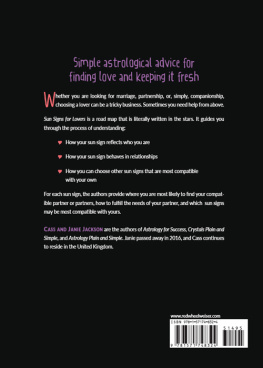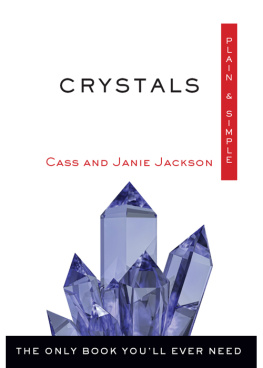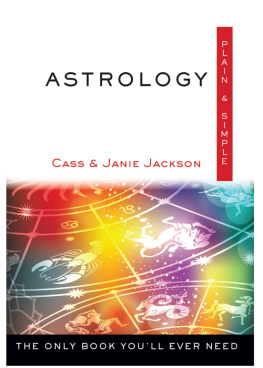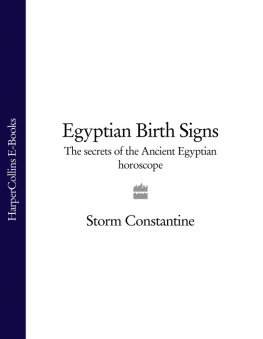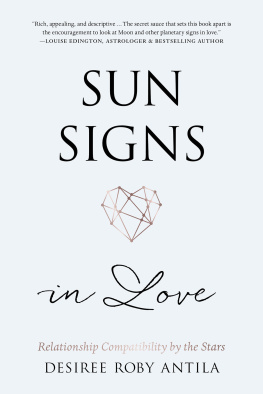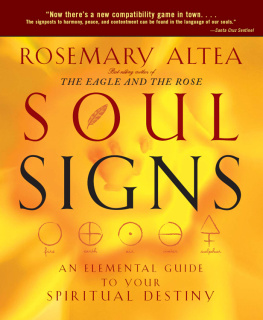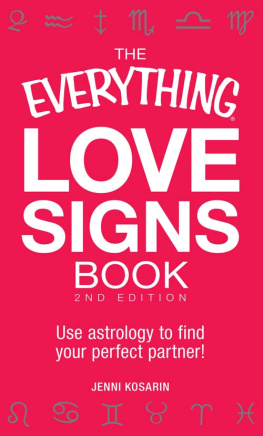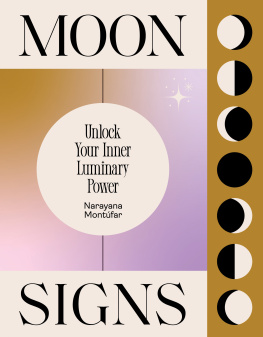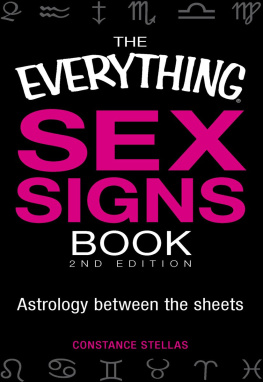

Dedicated to those who choose their lover carefully, and
to Lynne and Colinwho did.
Copyright 2005, 2020
by Cass & Janie Jackson
All rights reserved. No part of this publication may be reproduced or transmitted in any form or by
any means, electronic or mechanical, including photocopying, recording, or
by any information storage and retrieval system, without permission in writing from Hampton Roads
Publishing Company, Inc. Reviewers may quote brief passages.
Previously published in 2005 by Zambezi Publishing Limited, Devon, UK.
Cover and interior design by Kathryn Sky-Peck
Cover and Interior illustrations iStock.com
Hampton Roads Publishing Company, Inc.
Charlottesville, VA 22906
Distributed by Red Wheel/Weiser, LLC
www.redwheelweiser.com
Sign up for our newsletter and special offers by going to
www.redwheelweiser.com/newsletter/
ISBN: 978-1-57174-832-4
Library of Congress Cataloging-in-Publication Data available upon request
Printed in the United States of America
IBI
10 9 8 7 6 5 4 3 2 1
Contents
Introduction
M arriages, we're told, are made in heavenbut this institution appears to be going out of fashion in the twenty-first century. Judging from the number of marriages that end in disaster, it seems that heaven sometimes falls down on the job. However, whether you're looking for marriage or partnership, choosing a lover can be a tricky business. Where do you look for guidance? There are dozens of old wives' tales: Marry in haste, repent at leisure; Early brides make early deaths; and so on, but they're all pretty gloomy and often contradictory. Counseling is widely available, but this usually comes after you've made your choice and discovered your mistake.
Fortunately, there is a reasonably reliable system for choosing your mate. It's based on the theory that everything is written in the stars. We're not talking here about the daily horoscope features that appear in magazines and newspapers and on the Internet, because choosing the right partner is much more important than wondering what sort of day you're going to have. Whether you're being pursued by innumerable would-be lovers or are unable to make up your mind about old faithful, who has been around for years, you will find sound advice in this book that is based on the ancient theories of astrologyin addition to a few ideas from our own experiences as counselors.
We don't assume partnerships to be one man and one woman, nor do we assume that a partnership is made of two. What is written in the stars sees no classifications of gender, identity, or choice. This book has been written from the point of view of dual partnerships, but can easily be expanded to include all the loves in your life.
PART ONE
Sun Sign Basics
How Astrology Works
T o start with, of course, you will want to know something about how astrology works and how you can use it. Astrology is not a science, religion, cult, nor is it a Johnny-come-lately fad or fashion. It is knowledge that has existed for thousands of years. Scientists such as Isaac Newton and Galileo were also astrologers. Great generalsNapoleon, for instanceplanned their campaigns with astrological assistance, and it is well known that several world leaders have depended heavily on advice from astrologers. In the East, astrology is an integral part of life, and even in the cynical West, thousands of people read their horoscopes every day.
You almost certainly know your Sun signthat is, the sign of the zodiac covering the period in which you were born. Most people know, too, that for astrological purposes the year is divided into twelve sections, each represented by a certain sign.
The names given to these signs date back a long way, to the ancient civilizations of Egypt, Greece, and Rome. It is known that the Magi, the three wise men who searched for the Christ child, were astrologers, so convinced of the accuracy of their beliefs that they allowed a star to guide them. Until the seventeenth century, astrology was synonymous with astronomy. The ancient Greeks first established astrology as we now know it. The zodiac comprises the twelve constellations that lie along the apparent trajectory of the Sun around the Earth. Astronomers and astrologers call this pathway the ecliptic. We all know, of course, that the Earth orbits the Sun, but the ancients didn't understand this. Hence the use, even today, of phrases such as The Sun is now entering the sign of Cancer and so on. Stroll around a tree and notice how the view behind it changes as you walk. You will understand then the old idea that the Sun was moving through the signs and circling around the Earth.
The term zodiac derives from the word zoo and relates to the fact that certain constellations (groups of stars) look like animals or peoplefor example, the sign of the ram, bull, twins, crab, and so on. We've all heard of Ursa Major (the Great Bear), Orion the Hunter, and many others. You may like to take a map of the stars outside with you on a clear, starry night to see how many of these constellations you can locate in the sky.
Sun Signs
In order to explain how astrology can help you to find the love of your life, we must first define the dates covered by each sign. The zodiac circle begins on March 21, which equates to the start of the ancient Roman year, and it starts with the sign of Aries. It then works its way through to the last sign, which is Pisces. Astrologers describe your birth sign as a Sun sign because the Sun was in Taurus, Gemini, or whatever sign, on the day you were born.
Astrological signs are always expressed in the same order, with Aries as the first sign of the zodiac and Pisces as the twelfth, but the date on which each sign starts changes a little from time to time. For example, although the first day of Aries is usually March 21, it can sometimes be on the twentieth. Although each new sign starts when the Sun appears to move into it, this movement does not occur at a set time or date every year. Thus, the dates that follow are average ones, similiar to the ones that appear in any newspaper or magazine horoscope column.
AVERAGE SUN SIGN DATES
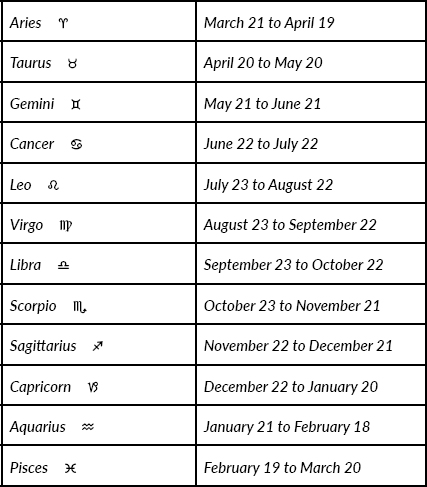
Born on the Cusp
Being born on the cusp may sound rather uncomfortable, but don't worry. It means only that you were born where one sign ends and another begins. If you're new to astrology, you may be confused, because some publications place you in one sign and some place you in another. There's an easy way to reach a decision about this. Simply surf the Internet using a search enginesuch as Googlewhere you will find links to astrological Web sites such as www.sashafenton.com, with information about services that can provide you with an astrological chart. You'll be asked to give the place and date of birth for the person you're looking up, andif possibletheir time of birth. For the purposes of finding a Sun sign, it doesn't matter if you don't know the time of birthjust enter 12 noon.
Sun Sign Categories
F irst, look at the way the signs are divided up. Each fits into three different categories, known as genders, elements, and qualities.
The Genders
Each sign of the zodiac is either masculine or feminine. These descriptions have nothing to do with the sex of the person concerned. Some astrologers prefer the terms positive and negative; others refer to yang and yin. We use the standard astrological terms of masculine and feminine in this book. No matter how you choose to describe them, the signs alternate in the following order.
Next page
